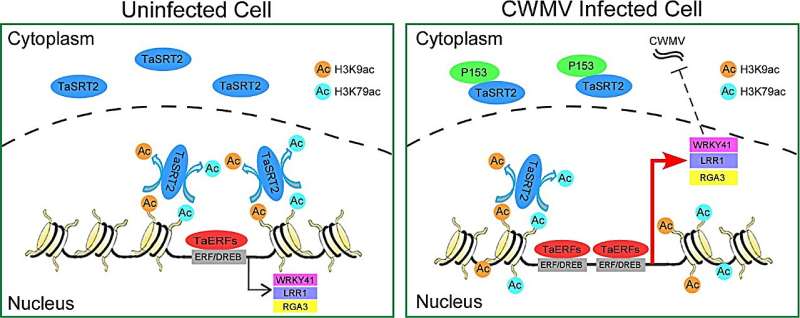This article has been reviewed according to Science X's editorial process and policies. Editors have highlighted the following attributes while ensuring the content's credibility:
fact-checked
trusted source
proofread
Researchers reveal how plants protect themselves from viral infection by regulating deacetylation

In a paper published in Science Bulletin, a team of Chinese scientists demonstrated that TaSRT2 recognized viral protein P153 and induced wheat resistance to CWMV through inhibition of the TaSRT2-mediated deacetylation of H3K9ac and H3K79ac, which eventually activated the expression of defense-related genes TaLRR1, TaRGA3, and TaWRKY41.
This study was led by Dr.Jian Yang and Dr. Kaili Zhong (State Key Laboratory for Managing Biotic and Chemical Threats to the Quality and Safety of Agro-products, Ningbo University). Their findings reveal a strategy that plants use to protect themselves from viral infection by regulating deacetylase function.
In this work, the team found CWMV infection induced H3K9ac and H3K79ac in wheat. Histone deacetylase TaSRT2 is demonstrated to deacetylate H3K9ac and H3K79ac since the levels of H3K9ac and H3K79ac were significantly reduced in TaSRT2 transgenic lines L6 and L8 plants but increased in virus-induced TaSRT2-silenced plants.
In addition, the researchers found that TaSRT2 transgenic lines L6 and L8 showed higher sensitivity to CWMV than the control. These findings suggest that TaSRT2 promotes the deacetylation of H3K9ac and H3K79ac, thereby increasing the susceptibility of wheat to CWMV.
The researchers also found TaSRT2 interacted with CWMV P153 and the binding affinity between TaSRT2 and P153 is important for wheat resistance to CWMV. The subcellular localization patterns of TaSRT2 revealed that CWMV or P153-GFP trapped TaSRT2 in the cytoplasm and decreased its nuclear localization. P153 also reduced the synthesis of TaSRT2.
In addition, P153 reduced the deacetylase activity of TaSRT2 for H3K9ac and H3K79ac. H3K9ac and H3K79ac eventually activated the expression of defense-related genes TaLRR1, TaRGA3, and TaWRKY41 which are regulated by transcription activators TaERF1 and TaERF039.
TaSRT2 may essentially exist to regulate the expression of genes functioning in development or defense. TaSRT2 recognizes viral protein P153 to induce itself silenced or turned over to activate host resistance upon CWMV infection. These results reveal a strategy used by plants to defend themselves from virus infections and suggest new ways to breed virus-resistant wheat and possibly other cereal crop cultivars.
More information: Kaili Zhong et al, TaSRT2 recognizes a viral protein to activate host immunity by increasing histone acetylation, Science Bulletin (2024). DOI: 10.1016/j.scib.2024.04.064
Provided by Science China Press




















